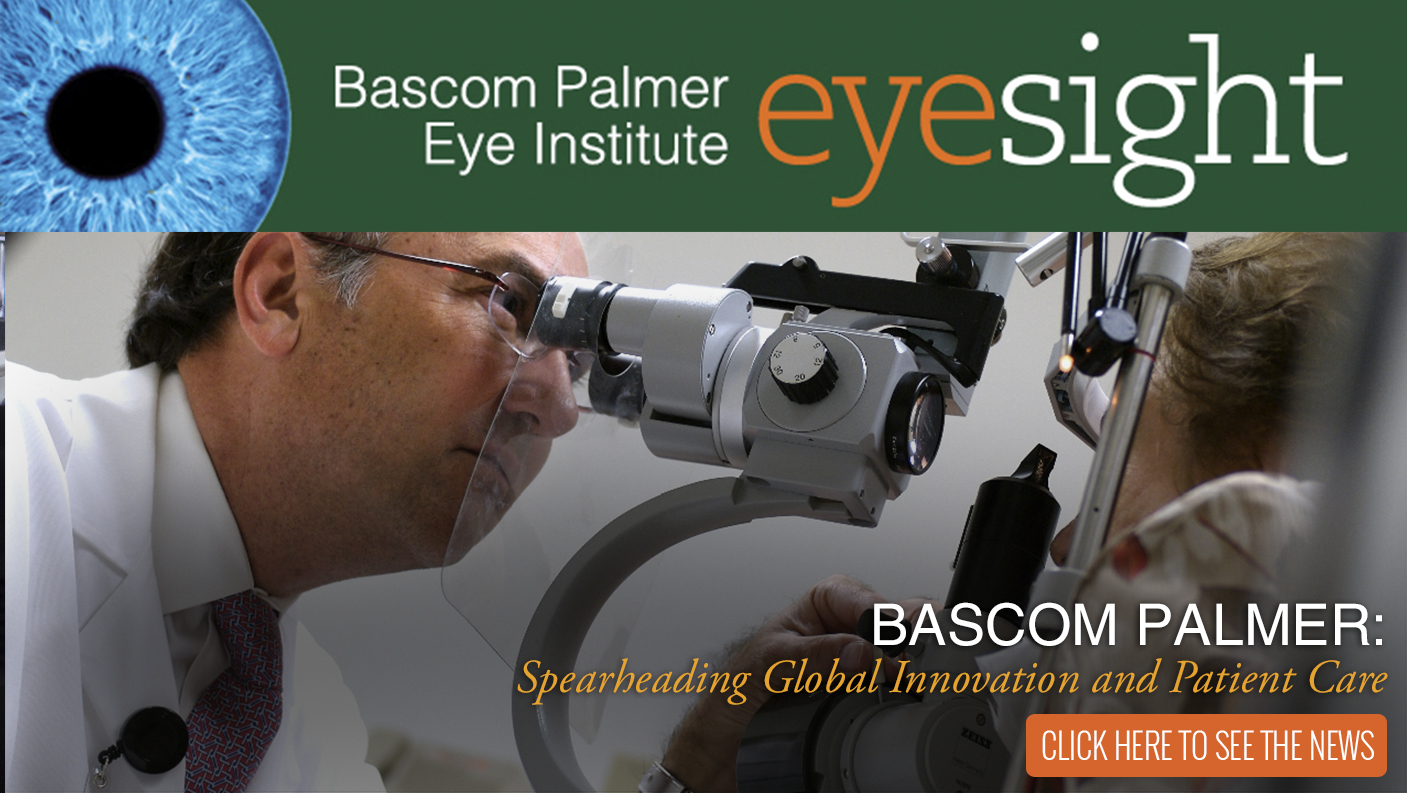
Volume 14, Number 2 |
February 2018 |

WELCOME to Review
of Ophthalmology's Retina Online newsletter. Each month, Medical Editor Philip Rosenfeld, MD, PhD, and our editors provide you with this timely and easily accessible report to keep you up to date on important information affecting the care of patients with vitreoretinal disease.
|

|
Macular Atrophy Incidence in Anti-VEGF-Treated nAMD: Treatment Need for Ranibizumab or Aflibercept
Investigators analyzed factors associated with macular atrophy incidence in neovascular age-related macular degeneration treated with ranibizumab or aflibercept in an observe-and-plan variable dosing regimen.
They obtained information from two identical prospective treatment protocols using ranibizumab or aflibercept in a variable dosing regimen. Eyes without MA at baseline were included. Investigators assessed new atrophy at the final two-year visit with univariate and multivariate analyses to identify associated risk factors, focusing on treatment factors.
De novo MA developed in 63 (42 percent) of 149 eyes/subjects (mean age 79 years), in 70 eyes treated using aflibercept and 79 eyes using ranibizumab. The univariate analysis showed multiple associations of MA with baseline factors, of which the following were confirmed as independent risk factors after multivariate stepwise logistic regression:
• lower number of anti-vascular endothelial growth factors injections (p=0.011);
• depigmentation (p=0.0004);
• reticular pseudodrusen (p=0.0005);
• lower baseline visual acuity (p=0.0006); and
• retinal angiomatous proliferation (p=0.001).
The drug type showed no significant association with MA incidence (p=0.21).
Investigators found that, within the variable dosing regimen, MA incidence was higher when fewer injections were required. They added that a greater number of injections, when required by disease activity, didn’t increase the risk for MA.
SOURCE Mantel I, Dirani A, Zola M, et al. Macular atrophy incidence in anti-vascular endothelial growth factor-treated neovascular age-related macular degeneration: Risk factor evaluation for individualized treatment need of ranibizumab or aflibercept according to an observe-and-plan regimen. Retina 2018; Jan 23. [Epub ahead of print].
Subfoveal Choroidal Thickness Predicts Macular Atrophy in AMD
Researchers assessed the relationship between subfoveal choroidal thickness and development of macular atrophy in eyes with age-related macular degeneration, as part of a prospective, multicenter study.
The study included 60 participants (120 eyes) in the TREX-AMD trial with treatment-naïve neovascular AMD in at least one eye. Certified reading center graders measured SCT at baseline using spectral-domain optical coherence tomography. They correlated baseline SCT with the presence of MA at baseline and development of incident MA by month 18. They used generalized estimating equations to account for information from both eyes.
Baseline SCT in MA eyes was statistically significantly less than in those without MA in dry AMD (p=0.04) and NVAMD (p= 0.01) groups. Comparison of baseline SCT between MA developers and non-MA developers revealed a statistically significant difference (p=0.03). ROC curve analysis showed the cutoff threshold of SCT for predicting MA development in cases without MA at baseline was 124 μm (AUC=0.772; sensitivity=0.923; specificity=0.5). Among eyes without MA at baseline, those with baseline SCT ≤124 μm were 4.3 times more likely to develop MA (OR: 4.3, CI: 1.6 to 12, p=0.005) than those with baseline SCT >124 μm.
Researchers found that eyes with AMD and MA had less SCT than those without MA. They added that eyes with less baseline SCT also appeared to be at higher risk of developing MA within 18 months.
Source: Fan W, Abdelfattah NS, Uji A, et al. Subfoveal choroidal thickness predicts macular atrophy in age-related macular degeneration: Results from the TREX-AMD trial. Graefes Arch Clin Exp Ophthalmol 2018; Jan 27. [Epub ahead of print].
Long-Term Therapy of nAMD With 50 or More Anti-VEGF Injections Using TES Protocol
Scientists analyzed the clinical results for individuals with neovascular age-related macular degeneration who were managed with a treat-extend-stop protocol and received 50 or more injections of anti-vascular endothelial growth factor agents, as part of a retrospective case study.
Using data from a private retina practice, scientists included the following criteria: diagnosis of nAMD and a history of 50 or more intravitreal injections of anti-VEGF agents. They obtained subjects’ baseline visual acuity (via Snellen charts and converted it to Early Treatment Diabetic Retinopathy Study letters), age, length of follow-up, anti-VEGF agents used and interval between treatments. These data were examined through the 51st injection and the last follow-up exam. Individuals were excluded if they lost significant vision because of a diagnosis unrelated to AMD during therapy. Main outcome measures included visual acuity and complications.
Sixty-seven eyes of 71 people met inclusion criteria (mean age: 83 years; 58.2 percent were women; 41.8 percent were men). Scientists found the following:
• the mean initial VA was 55.6 ETDRS letters;
• the mean duration of follow-up for the 51st injection was 6.4 years, and the mean duration of follow-up at the last visit was eight years;
• the mean number of injections at final follow-up was 63.7;
• the mean interval between treatments at the 51st follow-up was 5.4 weeks,
and the mean follow-up at the last exam was 6.4 weeks;
• the mean VA at the 51st injection was 65.3 letters, and the mean
change from baseline was 9.7 letters (p<0.001, student paired T test); and
• the mean vision gained at last follow-up was 8.7 letters from baseline (p<0.001), or 64.3 letters.
Individuals gained a mean of two ETDRS lines after 50 injections. Mean follow-up was eight years, and 35.2 percent of eyes had a three-line or more gain in VA at the last follow-up exam. Scientists wrote that managing individuals requiring consistent long-term anti-VEGF therapy with a TES protocol would likely be able to maintain or improve their vision.
SOURCE: Adrean SD, Chaili S, Ramkumar H, et al. Consistent long-term therapy of neovascular age-related macular degeneration managed by 50 or more anti-VEGF injections using a treat-extend-stop protocol. Ophthalmology 2018; Feb. 10. [Epub ahead of print].
Variants in CFH- and CFHR4- Associated with Systemic Complement Activation and AMD
Scientists identified genetic variants associated with complement activation to help select individuals with age-related macular degeneration for complement-inhibiting therapies, as part of a genome-wide association study followed by replication and meta-analysis.
Scientists performed GWAS on serum C3d-to-C3 ratio in 1,548 individuals with AMD and controls. An additional 697 individuals were genotyped for replication and meta-analysis. Scientists built a model for complement activation including genetic and non-genetic factors, and estimated the variance. They performed haplotype analysis for eight SNPs across the CFH/CFHR locus, and assessed associations with AMD for variants and haplotypes found to influence complement activation. The main outcome measure was normalized C3d-to-C3 ratio as a measure of systemic complement activation.
Complement activation was associated independently with rs3753396 located in CFH and rs6685931 located in CFHR4. A model including age, AMD disease status, body mass index, triglycerides, rs3753396, rs6685931 and previously identified SNPs explained 18.7 percent of the variability in complement activation. Haplotype analysis revealed three haplotypes (H1-2 and H6-containing rs6685931 and H3-containing rs3753396) associated with complement activation. Haplotypes H3 and H6 conferred stronger effects on activation compared with single variants (p=2.53 × 10-14; and p=4.28 × 10-4, respectively). Association analyses with AMD revealed that SNP rs6685931 and haplotype H1-2 containing rs6685931 were associated with a risk for AMD development, whereas SNP rs3753396 and haplotypes H3 and H6 weren’t.
Scientists found that the SNP rs3753396 in CFH and SNP rs6685931 in CFHR4 were associated with systemic complement-activation levels. They added that the SNP rs6685931 in CFHR4 and its linked haplotype H1-2 also conferred a risk for AMD development, and, therefore, could be used to identify individuals with AMD who would benefit most from complement-inhibiting therapies.
SOURCE: Lorés-Motta L, Paun CC, Corominas J, et al. Genome-wide association study reveals variants in CFH and CFHR4 associated with systemic complement activation. Ophthalmology 2018; Feb. 1. [Epub ahead of print].

Outcomes of PPV for Epiretinal Membrane in Eyes With Coexisting Dry AMD
Investigators wrote that limited evidence existed on the benefits of pars plana vitrectomy with membrane peel for epiretinal membrane in eyes with dry age-related macular degeneration. As such, they sought to assess anatomic and functional outcomes of PPV-MP for ERM in this subset of eyes, as part of a retrospective cohort study.
Participants included those with dry AMD who underwent PPV-MP for ERM from January 1, 2010, to December 1, 2016. Investigators recorded and analyzed the following:
• visual acuity and central foveal thickness, as measured on spectral-domain OCT for the preoperative, six-month and final follow-up visits;
• presence of cystoid macular edema and ellipsoid zone integrity compared with postoperative imaging;
• conversion to neovascular AMD, as confirmed by OCT or fluorescein angiography, in eyes for which at least two years of follow-up were available; and
• treatment with intravitreal anti-vascular endothelial growth factor compared with case eyes that underwent PPV-MP vs. fellow control eyes.
The main outcome measure included postoperative VA. A total of 38 eyes from 38 people met the study criteria. Investigators found a significant improvement in the median (interquartile range) logMAR VA:
• from 0.60 (IQR 0.46 to 1) (20/80, Snellen equivalent) at the preoperative visit; to
• 0.48 (IQR 0.30 to 0.70) (20/60, Snellen equivalent) at the six-month follow-up visit (p=0.04); to
• 0.48 (IQR 0.30 to 0.70) (20/60, Snellen equivalent) at the final visit (p=0.01).
Investigators determined a significant median decrease in CFT at the final visit (p<0.001) compared with the preoperative CFT. Only eyes with CME or intact EZ showed significant improvements in the median logMAR VA at the final (p=0.01) vs. preoperative visits (p=0.004). In a subgroup analysis of eyes with a minimum of two years of follow-up, four of 25 (16 percent) vitrectomized eyes and one of 25 (4 percent) fellow control eyes progressed to neovascular AMD (p=0.16).
Investigators determined that PPV-MP appeared to confer anatomic and functional improvement in eyes with ERM and coexisting dry AMD. They added that greater preoperative CFT, presence of CME and intact EZ were predictors of VA improvement in these eyes.
Source: Obeid A, Ali FS, Deaner JD, et al. Outcomes of pars plana vitrectomy for epiretinal membrane in eyes with coexisting dry age-related macular degeneration. Ophthalmology Retina 2018; Feb. 16. [Epub ahead of print].

Macular Thickening Following Intravitreous Aflibercept, Bevacizumab or Ranibizumab for Central-involved DME With Vision Impairment
Prevalence of persistent central-involved diabetic macular edema through 24 weeks of anti-vascular endothelial growth factor therapy and its longer-term outcomes may be relevant to treatment, researchers wrote. They assessed outcomes of DME persisting at least 24 weeks after randomization to treatment with 2-mg aflibercept, 1.25-mg bevacizumab or 0.3-mg ranibizumab, as part of a post hoc analysis of a clinical trial among 546 of 660 participants (82.7 percent) meeting inclusion criteria for this investigation.
Participants underwent six monthly intravitreous anti-VEGF injections (unless they had success after three to five injections), and subsequent injections or focal/grid laser as needed per the protocol to achieve stability. Main outcomes and measures included persistent DME through 24 weeks, probability of chronic persistent DME through two years, and at least 10-letter (≥ two-line) gain or loss of visual acuity.
The mean age of participants was 60 years, 363 (66.5 percent) were white and 251 were women. Researchers found the following:
• Persistent DME through 24 weeks was more frequent with bevacizumab (118 of 180 [65.6 percent]) than aflibercept (60 of 190 [31.6 percent]) or ranibizumab (73 of 176 [41.5 percent]) (aflibercept vs. bevacizumab, p<0.001; ranibizumab vs. bevacizumab, p<0.001; and aflibercept vs. ranibizumab, p=0.05).
• Among eyes with persistent DME through 24 weeks (n=251), rates of chronic persistent DME through two years were 44.2 percent with aflibercept, 68.2 percent with bevacizumab (aflibercept vs. bevacizumab, p=0.03) and 54.5 percent with ranibizumab (aflibercept vs. ranibizumab, p=0.41; bevacizumab vs. ranibizumab, p=0.16).
• Among eyes with persistent DME through 24 weeks, the percentage of individuals with versus without chronic persistent DME through two years gaining at least 10 letters from baseline was: 62 percent of 29 eyes, compared with 63 percent of 30 eyes (p=0.88) with aflibercept; 51 percent of 70 vs. 54 percent of 31 (p=0.96) with bevacizumab; and 44 percent of 38 vs. 65 percent of 29 (p=0.10) with ranibizumab. Only three eyes with chronic persistent DME lost at least 10 letters.
Researchers determined that persistent DME was more likely with bevacizumab than with aflibercept or ranibizumab. Among eyes with persistent DME, eyes assigned to bevacizumab were more likely to have chronic persistent DME than eyes assigned to aflibercept, they found.
Researchers wrote that the results suggested that individuals experienced meaningful gains in vision with little risk of vision loss regardless of the anti-VEGF agent given or DME persistence through two years. Researchers advised that caution was warranted when considering switching therapies for persistent DME following three or more injections, as improvements could be due to continued treatment rather than switching therapies.
SOURCE: Bressler NM, Beaulieu WT, Glassman AR, et al. Persistent macular thickening following intravitreous aflibercept, bevacizumab, or ranibizumab for central-involved diabetic macular edema with vision impairment. JAMA Ophthalmology 2018; Feb. 1. [Epub ahead of print].

Contrast Sensitivity & Other Visual Function Outcomes in DME Following Switch to Aflibercept
Researchers assessed changes in contrast sensitivity, visual acuity, central retinal thickness and vision-related quality of life in subjects with recalcitrant diabetic macular edema switched from long-term ranibizumab treatment to aflibercept.
In the prospective, investigator-masked, single-center study, 40 individuals with persistent fluid despite previous ranibizumab treatment were switched to aflibercept with five consecutive monthly doses. The primary outcome was mean change from baseline to week 20 in Pelli-Robson CS. Secondary outcomes were mean change from baseline in best-corrected VA, CRT and National Eye Institute 25-Item Visual Function Questionnaire score.
Researchers evaluated 50 eyes (baseline VA >6/30). A median of 21.1 ±11.9 (range, five to 55) ranibizumab injections were administered prior to initiation of aflibercept. They found:
• mean CS improved from 1.40 ±0.14 log units at baseline to 1.46 ±0.15 log units at week 20 (p<0.001);
• VA improved with mean logMAR BCVA of 0.33 ±0.19 at baseline compared with logMAR BCVA of 0.28 ±0.16 at week 20 (p=0.0016); and
• mean CRT decreased from 324 ±85 to 289 ±61 µm (p<0.001). Twenty-two (55 percent) individuals experienced an overall improvement in the National Eye Institute 25-Item Visual Function Questionnaire score.
Researchers found an association between changes in CS and CRT (r2=0.385, p<0.001) and changes in BCVA and CRT (r2=0.092, p=0.032).
Switching from ranibizumab to aflibercept in recalcitrant DME resulted in an improvement in all measured metrics, including CS, VA and CRT. A majority of individuals also indicated an improvement in vision-related quality of life. Researchers suggested that a stronger relationship between changes in CRT and CS than CRT and BCVA indicated that inclusion of CS as an endpoint might yield a more complete understanding of visual outcomes than by using VA alone.
Source: Nixon DR, Flinn NAP. Evaluation of contrast sensitivity and other visual function outcomes in diabetic macular edema patients following treatment switch to aflibercept from ranibizumab. 2018 Clin Ophthalmol;12:191-7.

Antiplatelet & Anticoagulant Agents in Vitreoretinal Surgery
Investigators assessed the rate of hemorrhagic complications after vitreoretinal surgery and the influence of antithrombotic agents.
Hemorrhagic complications of vitreoretinal procedures performed in seven ophthalmologic centers on individuals treated or not treated with antiplatelet or anticoagulant agents were prospectively collected. Patients’ characteristics, surgical techniques and complications were recorded during surgery and for one month after.
A total of 804 procedures were performed between January 2015 and April 2015—18.4 percent with AP agents (n=148), and 7.8 percent with AC agents (n=63); 18 included new oral anticoagulants. AP agents were continued in 96.5 percent of cases, and AC agents were continued in 80.7 percent of cases. Fifty-three subjects (6.6 percent) developed one or more hemorrhagic complications in one eye during this period. In univariate analyses, AC agents were not associated with hemorrhagic complications (p=0.329) in contrast with AP (p=0.005). However, in multivariate analyses, AP agents were not associated with hemorrhagic complications; intraoperative use of endodiathermy was the only factor associated with hemorrhagic complications (p=0.001).
Investigators found that AP and AC agents weren’t factors associated with hemorrhagic complications during vitreoretinal surgery. They suggested that continuation of these treatments could be considered without risk of severe hemorrhagic complications.
SOURCE Meillon C, Gabrielle PH, Luu M, et al. Antiplatelet and anticoagulant agents in vitreoretinal surgery:A prospective multicenter study involving 804 patients. Graefes Arch Clin Exp Ophthalmol 2018; Jan 23. [Epub ahead of print].

|



